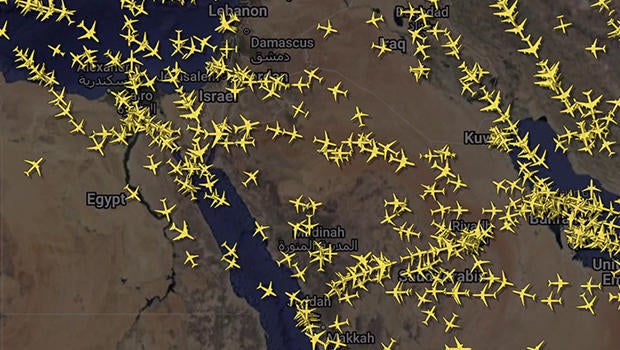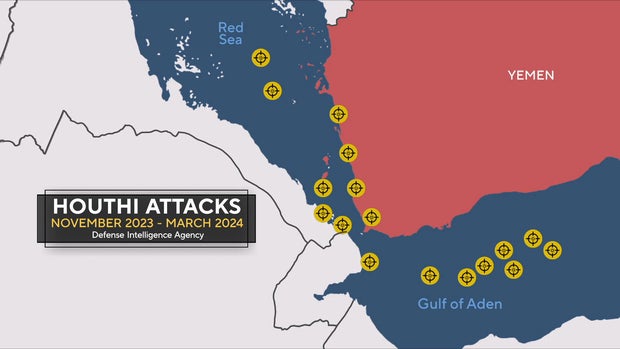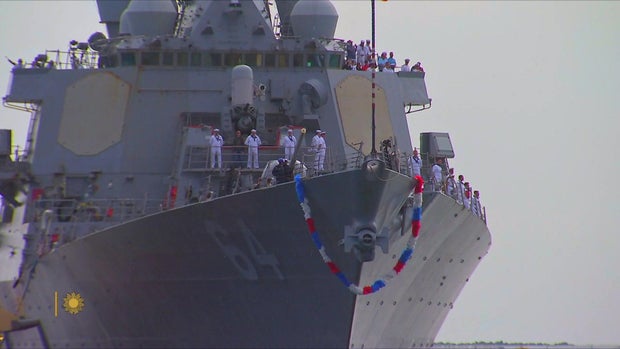In May, the destroyer USS Carney returned to Mayport, Florida, at the end of a seven-month tour of the Middle East—a journey unlike any other. For Commander Jeremy Robertson and his crew, the war between Israel and Hamas turned a routine deployment into a constant firefight against the Iranian-backed Houthi rebels in Yemen.
It began shortly after the ship entered the Red Sea through the Suez Canal. “We were getting indications that there was a possible attack coming from the south toward Israel,” said Lt. Dennis Morral.
The Houthis had sided with Hamas and launched a stream of cruise missiles and drones (also known as unmanned aerial vehicles or UAVs) towards Israel. “I think there were somewhere between 25 and 35 land-attack UAVs and cruise missiles launched, and some of them went into the Red Sea,” Robertson said. “We picked up the very first one-way attack UAV on our system, about 60 or 70 miles away.”
Robertson went to the ship’s Combat Information Center: “I got to Combat sometime around 5:00, 5:30 and didn’t leave until about 2:00,” he said.
The Carney tracked and intercepted drones and missiles that came within range – the first American shots fired in defense of Israel. “Whether they would have actually reached Israel is unknown,” Robertson said, “but they were certainly far from home, and there were certainly many of them.”
The Carney fired at more than 15 targets.
Martin asked, “Has any ship of the United States Navy ever fought such a battle?”
“Not since World War II,” Robertson replied. “It’s been a really long time.”
Mass Communications Specialist 2nd Class Aaron Lau, U.S. Navy
Lt. Cdr. Rebekah Fleming, who oversees all of the systems that come together at the Combat Information Center, said, “It was intense. When it came time for the real thing, I can’t say anyone was shocked because we had trained for it, but it was surreal.”
The fight lasted nine hours. Then, Robertson said, “it just stopped, and we stood there and looked at each other like, ‘Wow, did that really happen?'”
The Carney doesn’t look heavily armed; only a single gun mount is visible on the foredeck. But Lt. Kenny Shook, the ship’s weapons officer, showed “Sunday Morning” the launch tubes that contained the real firepower. “As soon as we give the command to engage, the cell hatch opens and the missile goes out to take out the target,” Shook said.
During its stay in the Red Sea, the Carney shot down 45 of 50 slow-flying drones and faster-flying missiles (ballistic and cruise missiles) that targeted commercial ships transiting to and from the Suez Canal.
Robertson said the ballistic missiles concerned him most: “You’re looking at something coming at you at Mach 5, Mach 6. The watchstanders have somewhere between 15 and 30 seconds to intervene.”
It was the Navy’s first ever real test against a supersonic missile. “The computer spits out where it’s going and the altitude and all very quickly of course,” Robertson said, “but people have to push the buttons.”
Before pressing a button, the captain had to determine whether the computer was tracking a legitimate target in a part of the world crossed by commercial aircraft.
This is what the airspace looked like that night:
Flight conscious
“Of course I’m very concerned that I’m shooting the wrong thing,” Robertson said.
The Carney was to escape to refuel and replenish its supplies at sea, but had to go into port to pick up more rockets, which are too large to be transferred en route.
It was firing million dollar missiles at thousand dollar drones. Robertson says no one has encouraged him to use fewer missiles: “Not once. I have been entrusted with this asset of $2 billion and 300-plus lives, and so the cost-benefit analysis for me is to fire off a missile firing is definitely my thing, and I’ll do it all day and twice on Sunday.”
The Carney also fired its main gun, but that has a much shorter range, and Robertson was determined to keep the Houthi drones and missiles as far away as possible. “We’ve never had anything even remotely close,” he said, close was within five miles.
But the Carney and the other Navy ships patrolling the Red Sea could not protect every commercial ship from Houthi attacks. One ship sank.
The Defense Intelligence Agency planned the successful attacks over a four-month period:
CBS News
By the time the Carney sailed for home, the Red Sea was still not clear—and the destroyer battles were not over. “We were called back,” Robertson said, “and we were underway again, heading for the eastern Mediterranean.”
On the night of April 14, Iran launched more than 300 drones and missiles against Israel. The Carney’s journey ended as it began: an incoming missile was shot down. “We shot in defense of Israel,” Robertson said.
The last shot Carney fired before heading home, the battle flag flying, changed the crew forever.
In Mayport, a young crew member told reporters, “I left a different person. And I came back a stronger person. I think I’ll be able to live with that for the rest of my life.”
CBS News
For more information:
Story produced by Mary Walsh. Editor: Mike Levine.












